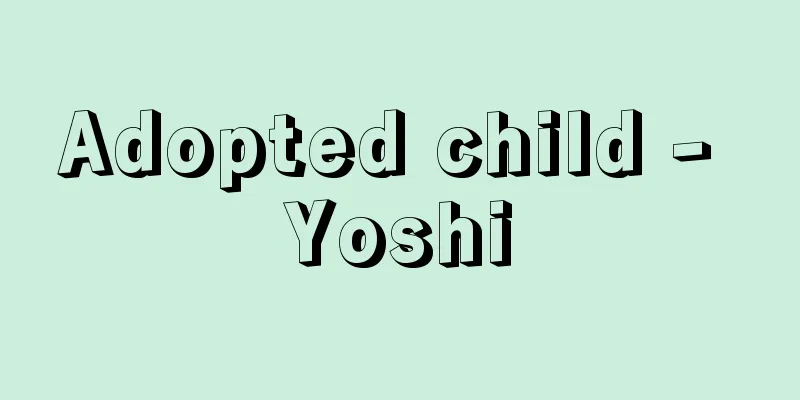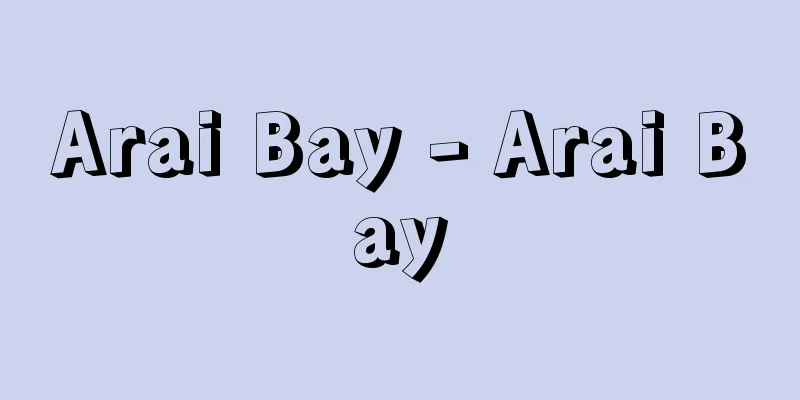Adopted child - Yoshi

|
A person who has become a child through adoption. Legally, he or she is treated as having a blood relationship with the adoptive parents, and therefore is to be treated the same as the adoptive parents' biological children. [Toshimi Takeuchi] HistoryThere is old evidence of the Japanese adoption system in the "Koryo" (an ancient compilation that stipulated the state's control of the people and the class system) which states, "Anyone without a child may adopt a relative of the fourth degree or higher who meets the standards of respect." However, this provision, which was transferred from the "Tang Code," did not fit the national conditions, so in practice adoption was widespread regardless of blood ties or lineage, and it showed a special development especially in medieval samurai society. There, adopted children were also called "adopted children" and were also referred to as "raising them as biological children," and not only were adopted children who inherited the "family headship," but the form of "adopted children on separate families" was widely practiced, which was also the main driving force behind the development of "family clans and households" under the sōryō system. In addition, when the biological child was young, adoption as an "intermediate successor (substitute successor)" was widely seen, and adoption of widows (women) was also permitted. Under the feudal system of the early modern period, under the "red seal system," the granting and taking away of samurai "chigyo (family stipend)" was the sole discretion of the "lord (shogun or daimyo)," so "inheritance adoption" required the lord's approval, which, in conjunction with the shogunate's policy of controlling daimyo, gave rise to complex adoption practices. In addition to regular adoptions (in cases where there were no children), there were special adoptions such as regular adoptions (younger brothers), son-in-law adoptions (son-in-laws), and terminal adoptions (adopted at the time of death). In particular, "terminal adoptions" were invented to prevent the abolition of daimyo families, and rather, in the early modern period, in order to exclude influential outside daimyo, "approval of adoptions" was strictly restricted. "Terminal adoptions" were a form of emergency adoption at the time of death, which the shogunate approved. In essence, it was a desperate measure to prevent the abolition of daimyo families due to sudden changes, and even a system of "insurance" temporary adoptions such as "emergency adoptions," "special adoptions," and "provisional adoptions" was created in case of sudden changes while traveling to distant lands. However, the form of "adoptions from a different family" has almost disappeared, and regulations on women were loosely applied, with the alternative name of "adopted daughters," and many were used to give "family status" at the time of marriage. In the early Meiji period, the legal system continued the system of early modern samurai families, and only allowed adoption to the head of the household and the heir, adhering to the line of "family" succession, but the "Civil Code" removed this restriction and also allowed personal adoption. However, while the survival of the "family system" still strongly retained the form of "adopted heirs," individuals (employers) were also free to adopt children, which was abused for the exploitation of women's labor in pleasure quarters and other places. Most adoption practices among common people were also carried out for the purpose of inheriting the "family (family name and family fortune)," and the "adopted heir" system, where a husband was adopted for a daughter or adopted daughter, was common, and in cases where there were no children, a young girl was first adopted and then an "adopted son-in-law" was adopted for her, in consideration of what would happen after the birth of a biological child. There were also other special practices such as "adopted son-in-law" adopting a youngest brother, "adopted son-in-law" adopting a married couple, or "adopted son-in-law" purchasing a declining "family" and inheriting it. On the other hand, there were also various cases where a "adopted son-in-law" was adopted for a daughter to supplement the household labor force, and then the child was placed in a separate household, or where an infant was taken in as a yashinaigo or moraiko with the promise of future "independence" and made to work in the household as an adopted servant. These were completely separate from adopted children who inherited the "family" and were taken in as family members for the purpose of running the "family" and had nothing to do with legal adoption, but they shared the same relationship of protection and service as "parents and children" and were also responsible for their future livelihood. Today, these types of adopted servants have almost disappeared, but in fishing villages and other areas, there are a few cases where they have been transferred to "foster children" under the child welfare system. [Toshimi Takeuchi] Changes in adoption lawThe adoption system has been recognized by many ethnic groups and nations since ancient times, but in times when the family system was strong, there was a principle that the family line must be inherited by someone related by blood, especially a male. If a person had no males, it was necessary to adopt a male from another family to inherit the family line, and the adoption system was used solely to serve this purpose (adoption for the family). As the family system declined, this type of adoption gradually disappeared, and the adoption system was used solely for the comfort and benefit of parents, such as to satisfy the "parental instinct" of childless parents who wanted to have children, to help their parents with their work, or to have their children take care of them in their old age (adoption for the parents). Then, especially after World War I, the adoption system came to attract attention as the best way to provide a warm home and ensure healthy and happy upbringing for the many orphans, mixed-race children, illegitimate children, and other unfortunate children born because of the war. Since the end of World War II and again in the 1960s, adoption laws and systems have undergone rapid reform and development in countries around the world. Adoption laws in these countries have gone beyond the realm of family law and are even said to be a kind of social legislation (adoption for children). Unlike these other countries, Japan had a long history of family systems, and the Meiji Civil Code, for example, recognized adoption by will and adoption as a son-in-law, and had a very strong character of adoption law for the benefit of the family. Efforts were made to modernize adoption laws after the Second World War, such as by requiring the permission of a family court for the adoption of minors, but many elements of the "family" still remain, and in reality, the majority of adopted children are adopted as adults, clearly demonstrating the outdated nature of national sentiment and consciousness. It is noteworthy that the 1987 (Showa 62) amendment to the Adoption Law (implemented in 1988) established a new system of "special adoption," which is completely different from the previous system of adoption (hereinafter referred to as ordinary adoption).While ordinary adoption is established by a contract between adoptive parents and child (contract type), special adoption is established by a ruling from a family court (declaratory type), and while in ordinary adoption the family relationship with the biological parents (relatives who are naturally related to the adopted child by blood) continues even after the adoption (incomplete adoption), in special adoption the relationship with the biological parents is completely severed upon adoption (complete adoption), which suggests a strong attitude to strengthen the unity between parent and child and eliminate unjustified interference from the biological parents, thereby promoting the welfare of the "child." [Masanori Yamamoto and Masamitsu Nozawa, May 21, 2021] Adoption is finalizedAdoption is established when the prospective adoptive parents and the prospective adopted child agree (Civil Code Article 802, item 1) and submit an adoption notification (Article 739 applied mutatis mutandis pursuant to Article 799 of the same law). In order for the adoption notification to be accepted, the following requirements must be met for the parties involved: (1) Foster parents must be of legal age (Article 792 of the same law). Minors are considered to have reached legal age by marriage (fictional adulthood, to be abolished in 2022), and so can be considered to be adoptive parents. There are no restrictions on the age of the adopted child, other than that the child must not be older than the adoptive parents (Article 793 of the same law). (2) It is not permitted to adopt one's ascendants, such as uncles and aunts, even if they are younger than oneself (Article 793 of the same law). As long as they are not ascendants, one can adopt not only cousins and sisters, but also younger brothers, sisters, grandchildren, and even one's illegitimate children. (3) When a married person adopts a minor, the adoption must be made jointly with the spouse. However, when one spouse adopts the other's legitimate child or when the other is unable to express his or her intention, the adoption may be made by one spouse alone (Article 795 of the same law). Next, when one spouse adopts an adult or when one spouse is adopted, the consent of the other spouse must be obtained. However, when a spouse adopts jointly or when the other is unable to express his or her intention, the consent of the other spouse is not required (Article 796 of the same law). (4) If the person to be adopted is under 15 years of age, his/her legal representative, i.e., the parent or guardian, must consent to the adoption on behalf of the child (substitute adoption). When the parents are divorced, or the father has acknowledged paternity of a child out of wedlock, and one parent is designated as the parent and the other as the guardian, the person with the parental authority is the one who has the power to consent on behalf of the child, but the consent of the guardian is required (Article 797 of the Child Welfare Act). In addition, according to the Child Welfare Act, the head of a child welfare institution may, with the permission of the prefectural governor, consent on behalf of a child currently admitted to the institution over whom the head of the institution exercises parental authority (Article 47 of the Child Welfare Act). (5) When adopting a minor, unless the person is a direct lineal descendant (child, grandchild, etc.) of the person himself or her spouse, the adoption notification cannot be filed without the permission of the family court (Civil Code Article 798). This provision was established solely for the welfare of children, but the majority of adopted children in Japan are adult adoptees, and the majority of adopted minors are also direct lineal descendants of the person himself or her spouse. (6) In order for a guardian to adopt a ward (either a minor or an adult), he or she must obtain the permission of the family court (Article 794 of the same Act). This is to prevent the guardian from evading supervision over the management of assets by adopting the ward. (7) There must be a consensus between the parties to adopt (Article 802, paragraph 1 of the same law). Regarding the specific content of the adoption intention, there are theories that interpret it substantively and those that interpret it merely formally, and case law has taken the former position. [Masanori Yamamoto and Masamitsu Nozawa, May 21, 2021] The Effects of AdoptionWhen the adoption notification is accepted, the adopted child acquires the status of the legitimate child of the adoptive parents from the date of adoption (Article 809 of the Civil Code), and a kinship relationship similar to that between blood relatives is created between the adoptive parents and their blood relatives and the adopted child, resulting in a mutual relationship of inheritance and support obligations. No relationship is created between the blood relatives of the adopted child at the time of adoption, such as the adopted child's parents and children, and the adoptive parents and their blood relatives. Next, the adopted child takes the surname of the adoptive parents and, in principle, is registered in the adoptive parents' family register. However, if a person changes their surname at the time of marriage, their surname will not change during the duration of the marriage, even if they are adopted (Article 810 of the same law). When an adopted child is a minor, he or she is free from the parental authority of his or her biological parents and is subject to the parental authority of the adoptive parents. Even after adoption is established, the relationship with the biological parents and their relatives is not affected in any way except in terms of parental authority, so for example, an adopted child can inherit the property of both the adoptive parents and the biological parents. [Masanori Yamamoto and Masamitsu Nozawa, May 21, 2021] Special AdoptionSpecial adoption is established by a ruling from the family court (Article 817-2 of the same law). Only married couples may apply for this adoption, and the couple must become the adoptive parents jointly, except when one of them adopts the other's legitimate child (Article 817-3 of the same law). Adoptive parents must be at least 25 years old. However, if one of the adoptive couple is at least 25 years old, the other may become an adoptive parent as long as he or she is at least 20 years old (Article 817-4 of the same law). The person to be adopted must be under 15 years old at the time of the adoptive parents' application (Article 817-5 of the same law). Before the 2019 (Reiwa 1) revision of the Civil Code, "a person to be adopted must be under the age of 6, and a person who has been under the custody of the adoptive parent since before reaching the age of 6 may be under the age of 8 at the time of the request (former Article 817-5 of the same law)." This was because it was thought that in order to build a substantial parent-child relationship between an adopted child and an adoptive parent, care from an early age is necessary. However, this means that even if there is a high need for adoption, once a child turns 6 years old, they will no longer be eligible for special adoption. In particular, many children are placed in child welfare institutions due to having no guardians or being abused, and many of these children would be better off being raised at home through special adoption, so there was a desire to relax the requirements for special adoption. Therefore, the amendment to the Civil Code enacted on June 7, 2019 raised the upper age limit for those who can be adopted through special adoption, and required that they be under 15 years old at the time of filing a petition for a ruling on the establishment of special adoption (Article 817-5, Paragraph 1, first part of the Civil Code). In addition, even if the person to be adopted is over 15 years old, special adoption is possible if (1) the adoptive parents have been raising the child since before the child reached 15 years old, and (2) the petition for a ruling could not be filed by the time the child reached 15 years old due to unavoidable circumstances (Civil Code, Paragraph 2). Thus, the reason why the standard for special adoption is 15 years old is because people over 15 years old can apply for ordinary adoption themselves. However, people who reach 18 years old before the establishment of special adoption cannot be adopted (Civil Code, Paragraph 1, second part of the Civil Code). In addition, if the person to be adopted is 15 years old at the time of the ruling, his/her consent is required (Civil Code, Paragraph 3). The adoption requires the consent of the parents of the child to be adopted. For a natural child, the consent of the natural parents is required; for an adopted child, the consent of the adoptive parents and the natural parents is required; for a special adopted child, the consent of the adoptive parents is required. However, consent is not required when the parents are unable to express their wishes or when there is a reason on the part of the parents that would seriously harm the interests of the child to be adopted, such as abuse, malicious abandonment, or other reasons (Article 817-6 of the same law). Special adoption may be established only when it is deemed extremely difficult or inappropriate for the parents to care for the child to be adopted, or when other special circumstances exist, and it is particularly necessary for the child's interests to be specially adopted (Article 817-7 of the same law). Furthermore, to establish an adoption, the adoptive parents must take into consideration the fact that they have taken custody of the child to be adopted for a period of six months or more (Article 817-8 of the same law). Since special adoption is also a type of adoption, the effects of ordinary adoption are recognized in this case as well. However, with the establishment of special adoption, all kinship relationships between the adopted child and his/her natural parents and their blood relatives are extinguished (Article 817-9 of the same law), with the exception of marriage barriers recognized based on physiological blood ties (prohibition of marriage between close relatives and between lineal relatives by marriage; Articles 734 and 735 of the same law). This is completely different from the case of ordinary adoption. In addition, once the special adoption decision is finalized, the adoptive parents who requested the adoption must notify the adoption within 10 days. If the notification is filed, a new family register is first compiled for the adopted child in the adoptive parents' previous permanent domicile under the adoptive parents' surname, and the adopted child is then registered in the adoptive parents' family register (Family Register Law, Article 18, Paragraph 3), and the previous new family register is immediately deleted. In this way, the direct relationship between the adoptive parents and the biological parents is completely severed, but the relationship between the two family registers can be known through the intermediate deleted family register. In addition, the status information column for the adopted child in the adoptive parents' family register will state "... the decision has been finalized under Article 817, Paragraph 2 of the Civil Code...", but there is no column for adoptive parents, and the adoptive parents are listed as biological parents, and the relationship is not listed as "adopted child" but as in the case of a biological child, for example, as "eldest son," and the entry on the resident's card will be similar to this. In principle, divorce is not permitted, but in very rare cases it may be granted by arbitration (Civil Code Article 817-10). [Masanori Yamamoto and Masamitsu Nozawa, May 21, 2021] Special Adoption through Adoption MediationThere were two ways to find a child for special adoption: through a child consultation center or through a private agency that mediates adoption. In particular, special adoptions through private agencies accounted for about 40% of all adoptions, and considering that there are about 200 child consultation centers nationwide, but only about 20 private agencies (Ministry of Health, Labor and Welfare, 2016 Survey Results on Special Adoptions), the importance of private agencies was clear. Despite this, the financial foundation of private agencies was weak and they received no financial support from the national or local governments. In addition, private agencies could operate adoption businesses by simply applying, and there were no penalties, so some malicious operators existed. Therefore, in 2016, the Act on Protection of Children in Adoption Mediation by Private Mediation Agencies was enacted and came into effect on April 1, 2018. The purpose of this law is to "implement a licensing system for those who operate adoption mediation businesses and take measures to ensure the proper operation of their businesses" (Article 1), and stipulates that those who wish to operate "adoption mediation businesses" must obtain a license from the prefectural governor (Article 6). On the one hand, the prefectural governor supervises "private mediation agencies," and on the other hand, it stipulates that "the national or local government may take the necessary financial measures to support private mediation agencies, training for those engaged in the business of adoption mediation, and other measures" (Article 22) to provide assistance to them. Furthermore, anyone who operates a special adoption mediation business without a license is subject to imprisonment of up to one year or a fine of up to one million yen (Article 44). It is expected that the enforcement of this law will promote proper special adoption mediation by "private mediation agencies." [Masami Nozawa May 21, 2021] International AdoptionThere is a wide variety of legal systems regarding adoption in each country. For example, adoption is prohibited in Islamic countries. On the other hand, among countries that allow adoption, there are countries that only allow traditional adoption (ordinary adoption), in which the adopted child maintains his/her kinship relationship with his/her biological relatives, has the obligation to support his/her biological parents, and also has the right to inherit the property of his/her biological parents, and countries (including many Western developed countries and Japan) that also allow new types of adoption (special adoption or severed adoption), which severes the kinship relationship between the adopted child and his/her biological relatives. There are also differences between countries that adopt a deterministic adoption system that allows adoption by court decision, and countries that also allow contractual adoption, which allows adoption by agreement between the parties. These differences in domestic laws are rooted in religion, culture, etc., and it is almost impossible to create a global unified law. Therefore, legal order is provided by private international law, which determines which country's laws apply. According to Article 31 of the Act on General Rules for Application of Laws (Act No. 78 of 2006), a Japanese private international law code, adoptions shall be governed by the national law of the adoptive parents at the time of the adoption. This is because the lives of adoptive parents and children are usually centered around the adoptive parents, and so the national law of the adoptive parents is considered to be the law of the place with the closest connection. However, in the case of adoptive parents and children with different nationalities, there is a risk that the adopted child will be disadvantaged if the national law of the adoptive parents is governed solely by the national law of the adoptive parents, so there is a safeguard clause that requires that if the national law of the adopted child requires the consent or agreement of the adopted child or a third party, or the permission or other disposition of a public institution, for the adoption to be valid, this requirement must also be met (Proviso, Article 31, Paragraph 1 of the same Act). Furthermore, with regard to the termination of the familial relationship with the natural blood relatives that arise in the case of special adoption, one would normally think that it would be governed by the governing law of the relationship that is being terminated, i.e., in the case of a legitimate parent-child relationship, the governing law stipulated by Article 28 of the same law, but if that were to be the case, and the law of a country that does not have a special adoption system were the governing law of that relationship, then even if special adoption is made under the adoptive parents' governing law, the legitimate parent-child relationship with the natural parents would not be severed. Therefore, in order to fulfill the wishes of adoptive parents who wish to adopt a special child, Article 31, paragraph 2 of the same law stipulates that the termination of the familial relationship between an adopted child and his natural blood relatives shall be governed by the governing law of the adoption establishment. On the other hand, if divorce was to be governed by the applicable law of the adoptive parents at the time of divorce, there would be a risk that an adoption established as a special adoption under the applicable law of the adoptive parents at the time of the adoption would be granted if the requirements for divorce as a normal adoption were met simply because the national law of the adoptive parents was subsequently changed to the law of a country that does not have a special adoption system, even though divorce is subject to extremely strict restrictions under that law. Therefore, Article 31, paragraph 2 of the same law stipulates that divorce shall be governed by the applicable law of the adoptive parents at the time of the adoption. Regarding the legal relationship between adoptive parents and children, Article 32 of the General Rules for Application of Laws provides that, in the first stage, if the national laws of the adoptive parents and adopted child are the same, then that law shall govern, and if not, in the second stage, the law of the adopted child's habitual residence shall govern. Looking at the reality of international adoption, there is a strong tendency worldwide for people in developed countries to adopt children from developing countries. The background to this seems to be that in wealthy developed countries, the birthrate is declining, making it difficult for those who want to adopt to find suitable candidates within the country, while in poor developing countries, many children are born as a result of not controlling childbirth, and they become a source of adopted children. In between, brokers are also operating secretly, arranging for the adoption of children from developing countries to parents in developed countries, for their own profit rather than the happiness of the adopted children. In response to this, the United Nations stipulated in the "Convention on the Rights of the Child (Convention on the Rights of the Child)" (Convention No. 2 of 1994) that "all appropriate measures should be taken to ensure that in international adoptions, the adoption does not result in undue financial gain for the persons involved" (Article 21 (d) of the same Convention). In response to this, the Hague Conference on International Private Law adopted the "Convention on Protection of Children and Cooperation in International Adoption" in 1993, one of the purposes of which is to curb irresponsible international adoptions by such brokers. The treaty came into force in 1995 and is now signed by more than 90 countries (Japan has not yet ratified it). By the way, although there are no accurate statistics, it has been said that Japan, unlike other developed countries, is more likely to send children abroad for adoption than to accept children from abroad when it comes to international adoption. The reasons for this include domestic circumstances, such as: [Masato Michigauchi May 19, 2016] "Restatement of the Foreign Family Registry Law by Sato Yayoi and Michigauchi Masato (2007, Nihon Kajo Publishing) " "Yoshiko Tomita, "Adoption for the sake of children: Trends in special adoption" (The Journal of the Japan Society for Home Economics, Vol. 71, No. 1, p. 49, 2020)" [Reference items] | | Family | | Blood | | | Applicable law | Relatives | Inheritance | Adopted child of a married couple | | Adopted | law | |Source: Shogakukan Encyclopedia Nipponica About Encyclopedia Nipponica Information | Legend |
|
養子縁組によって子となった者。法律上、養親(養い親)と血のつながりがあるものとして扱われ、したがって、養親の実子と同じ取扱いを受けることになる。 [竹内利美] 沿革「凡無子者、聴養四等以上親於昭穆合者」(凡(およ)そ子(し)無くは、四等以上の親(しん)の、昭穆(しょうもく)に合(かな)えらん者(ひと)を養(やしな)うこと聴(ゆる)せ)と「戸令(こりょう)」(国家の人民掌握や身分制について定めた古代の編目)にあるのが日本の養子制の古い証跡だが、「唐令」を移したこの規定は国情にそぐわぬため、事実上は血縁の親疎有無や輩行にとらわれず、広く養子が行われ、とくに中世武家社会では特殊な発展を示した。そこでは養子は「猶子(ゆうし)」ともいい、また「実子にたてる」とも称して、「家督」継承の養子だけではなく、「養子別家」の形が広く行われて、総領制下における「一族家門」発展の主動因ともなった。また実子幼弱の際は「中継(なかつぎ)相続(名代(みょうだい)相続)」としての養子も広くみられ、後家身分(女子)の養子も認められていた。近世封建制下では「朱印制度」のもと武家の「知行(ちぎょう)(家禄(かろく))」の授与収奪は「主君(将軍・大名)」の専断となったので、「相続養子」は主君の認証を要し、それは幕府の大名統御策と絡んで複雑な養子慣行を生ずるに至った。 家督相続養子には通例の養子(無子の場合)のほか、順養子(弟)、婿養子(娘婿)、末期(まつご)養子(臨終にあたりたてる)などの特殊養子があり、とくに「末期養子」は大名家廃絶の動揺を防ぐため創案されたもので、むしろ近世初頭の有力外様(とざま)大名排除には「養子認許」を厳しく制限していたのである。「末期養子」は臨終にあたり急拠養子をたて、幕府がそれを認める形であって、要は急変による大名家の廃絶をとどめる苦肉の策であり、さらには「急養子」「心当(こころあたり)養子」「仮養子」という遠国旅中の急変に備えてのいわば「保険的」暫定養子制さえ生じた。しかし「別家養子」の形はほとんど消失し、また女子は「養女」と別称してその規制も緩やかで、多くは婚姻の際の「家格」付与に利用された。明治法制でも初期は近世武家の制を引き継ぎ、戸主と相続人に限り養子を認めるなど、「家」継承の線を固守していたが、「民法」ではその制限を外し、個人的養子も認められた。しかし「家制度」の存続は「跡取り養子」を主体とする形を依然強く残してきたが、一方、個人(雇主)の養子も自在となったので、遊里などの婦女労働の搾取にはそれが悪用もされた。 一般庶民の養子慣行もほとんど「家(家名・家産)」継承のため行われ、娘か養女に婿を迎える「跡取り養子」が一般的で、「無子」の場合には幼少の女子をまず「養女」として、それに「婿養子」をとる形が多かったのは、実子生誕後のことを思慮しての処置であった。そのほか末弟を迎える「順養子」や夫婦ともどもの「両養子(夫婦養子)」、あるいは衰退した「家」を買い取りながらそれを継ぐ形での「買い養子」などの特殊慣行もあった。一方、家内労働力を補充するため「婿養子」を娘に迎え、やがて別家させる形や、ヤシナイゴ・モライコとして将来の「独立」を約束して幼児を引き取り、家内労働に従事させる養子形式の奉公人もいろいろあった。これらは、「家」継承の養子とはまったく別個で、「家」経営のため家族の一員として取り入れられるもので、法的な養子縁組とは無縁の存在ではあったが、等しく「オヤコ」として保護奉仕の関係をもち、将来の生活の庇護(ひご)にもあたった。今日この類の養子奉公人はほとんど消失したが、漁村などの場合は、児童福祉制下の「里子」などにその残存が移行した例も若干ある。 [竹内利美] 養子法の変遷養子制度は、古くから諸民族、諸国家において認められた制度であるが、家族制度の強固な時代には、家は血縁のある者、ことに男の子によって承継されねばならないという原理が存在し、男の子のない者は他家の男の子を養子として家を承継させることが必要であり、養子制度はもっぱらこの目的に奉仕するものとして用いられた(家のための養子)。家族制度の衰微とともに、このような養子はしだいに姿を消し、それとともに、子のない親の、子をもちたいという「親としての本能」を満足させるため、あるいは親の労働に協力させるとか、さらには老後には子にめんどうをみてもらうために子を養子とするなど、もっぱら親の慰藉(いしゃ)、利益のために養子制度が利用された(親のための養子)。ついで、ことに第一次世界大戦後は、戦争のために生まれた多数の孤児、混血児、私生児、その他不遇な子に対し、温かい家庭を与え、その健全で幸福な育成を図る最良の手段として養子制度が注目されるに至った。第二次世界大戦後さらに1960年代以後における世界各国での養子法の改正、養子制度の発展にはめまぐるしいものがある。そこでは、養子法はもはや家族法の領域から脱して、一種の社会立法であるとさえいわれているのである(子のための養子)。 日本では、これら諸国と異なり、長らく家族制度が存続していたこともあって、たとえば、明治民法においても、遺言養子、婿養子縁組を認めるなど、家のための養子法の性格がきわめて強かった。第二次世界大戦後の法改正により、新たに未成年養子には家庭裁判所の許可を必要とするなど、近代的養子法への脱皮の努力がみられたが、依然として多分に「家」的な要素が残っており、また現実においても、養子の大半が成年養子であるなど、国民感情、国民的意識の古さをまざまざと見せつけられるのである。 注目すべきは、1987年(昭和62)の養子法改正(1988年施行)により、従来の養子(以下普通養子という)とまったく異なる「特別養子」の制度が新設されたことである。普通養子縁組が養親子間の契約により成立するのに対し(契約型)、特別養子は家庭裁判所の審判により成立し(宣言型)、また普通養子縁組では縁組後も実方(じつかた)(養子からみて、自分の自然血族関係にある親族)との親族関係が存続するのに対し(不完全養子)、特別養子では縁組により実方との関係がまったく断絶する(完全養子)のであり、そこには、親子一体感を強め実親からの不当な干渉を排除し、もって「子」の福祉を図ろうとする強い姿勢がうかがわれるのである。 [山本正憲・野澤正充 2021年5月21日] 養子縁組の成立養子縁組は、養親となろうとする者と、養子となろうとする者とが合意して(民法802条1号)縁組届をすることによって成立する(同法799条による739条の準用)。縁組届が受理されるためには、当事者について次のような要件が満たされていなければならない。 (1)養親は、成年に達していなければならない(同法792条)。未成年者も婚姻すれば成年に達したものとみなされる(成年擬制。2022年廃止)から養親となることができると解される。養子の年齢については、養親より年長であってはならない(同法793条)ということのほかには、なんらの制限もない。 (2)自分より年少者であっても、自分の尊属、たとえば伯叔父母を養子とすることは許されない(同法793条)。尊属でなければ、従兄弟姉妹はもちろんのこと弟や妹、孫、さらには自分の嫡出でない子でも養子にすることができる。 (3)配偶者のある者が未成年者を養子とする場合は、配偶者と共同で縁組しなければならない。ただし、夫婦の一方が他方の嫡出子を養子とする場合および他方が意思を表示することができない場合は、一方だけで縁組することができる(同法795条)。つぎに、夫婦の一方が成年者を養子とする場合および夫婦の一方が養子となる場合は、他方の同意を得なければならない。ただし、夫婦が共同で縁組する場合および他方が意思を表示できない場合は、その同意はいらない(同法796条)。 (4)養子となる者が満15歳未満のときは、その法定代理人すなわち親権者ないし後見人が、養子にかわって縁組の承諾をしなければならない(代諾縁組)。父母が離婚し、あるいは嫡出でない子を父が認知したなどして父母の一方が親権者、他方が監護者と定められているときは、代諾権者は親権者であるが、監護者の同意が必要である(同法797条)。また、児童福祉法によれば、児童福祉施設の長は、親権を行使している入所中の児童について、都道府県知事の許可を得たうえで代諾できるとされている(児童福祉法47条)。 (5)未成年者を養子とするときは、それが自分または配偶者の直系卑属(子、孫など)でない限り、家庭裁判所の許可を得たうえでなければ縁組届ができない(民法798条)。もっぱら子の福祉を図るため設けられた規定であるが、日本の養子の大半は成年養子であり、しかも未成年養子の多くも、自己または配偶者の直系卑属である。 (6)後見人が被後見人(未成年被後見人および成年被後見人)を養子とするには、家庭裁判所の許可を得なければならない(同法794条)。養子とすることによって、後見人が財産管理に関する監督を免れようとするのを防止するためである。 (7)当事者間に縁組をする意思の合致がなければならない(同法802条1号)。縁組意思の具体的内容については、これを実質的に解する説と、単に形式的に解しようとする説とがあり、判例は前者の立場をとっている。 [山本正憲・野澤正充 2021年5月21日] 養子縁組の効果養子縁組届が受理されると、養子は縁組の日から養親の嫡出子としての身分を取得し(民法809条)、養親およびその血族と養子との間には、血族間におけると同様な親族関係が発生するから、相互に相続関係、扶養義務関係が発生する。養子縁組当時の養子の血族、たとえば養子の父母や子などと、養親およびその血族との間にはなんの関係も生じない。次に、養子は養親の氏を称し、原則として養親の戸籍に入籍する。ただし、婚姻の際に氏を改めた者は、その婚姻継続中は、縁組によっても氏は変わらない(同法810条)。養子が未成年のときは、実親の親権から脱して養親の親権に服する。養子縁組が成立しても、実父母およびその親族との関係は親権の点を除いてなんらの影響を受けないから、たとえば養子は養父母と実父母との双方の財産を相続することができる。 [山本正憲・野澤正充 2021年5月21日] 特別養子縁組特別養子縁組は、家庭裁判所の審判によって成立する(同法817条の2)。この縁組を請求できる者は夫婦に限られ、しかも夫婦は、その一方が他方の嫡出子を養子とする場合を除き、共同で養親とならなければならない(同法817条の3)。養親は、25歳に達していなければならない。もっとも養親となる夫婦の一方が25歳に達していれば、他方は20歳以上であれば養親となることができる(同法817条の4)。養子となる者は、養親となる者の請求時に15歳未満でなければならない(同法817条の5)。 2019年(令和1)の民法改正前は、「養子となる者は、6歳未満でなければならず、6歳に達する前から引き続き養親となる者に監護されていた者は、請求のとき8歳未満であればよい(同法旧817条の5)」とされていた。これは、養子と養親との間に実質的な親子関係を築くためには、幼少期からの養育が必要であると考えられたことによる。しかし、そうすると、たとえ縁組みの必要性が高くとも、6歳を超えると特別養子縁組の対象ではなくなることとなる。とりわけ、児童養護施設等には、保護者がいないことや虐待を受けていることなどが原因で、多数の子が入所しているが、そのなかには、特別養子縁組を成立させることにより、家庭において養育することが適切な子も少なくなく、特別養子縁組の要件の緩和が望まれていた。そこで、2019年6月7日に成立した民法改正では、特別養子縁組の養子となる者の上限年齢を引き上げ、特別養子縁組の成立の審判の申立てのときに15歳未満であることを要件とした(民法817条の5第1項前段)。また、養子となる者が15歳以上であっても、(1)15歳に達する前から養親となる者が引き続き養育し、(2)やむを得ない事由により15歳までに審判の申立てができなかった場合には、特別養子縁組が可能となる(同第2項)。このように、15歳を特別養子縁組の基準としたのは、15歳以上の者は自ら普通養子縁組をすることができるからである。ただし、特別養子縁組が成立するまでに、18歳に達した者は、養子となることができない(同第1項後段)。また、養子となる者が審判の時に15歳に達している場合には、その者の同意が必要となる(同第3項)。 縁組の成立には、養子となる者の父母の同意が必要である。実子については実父母、養子については養父母および実父母、特別養子についてはその養父母の同意である。もっとも父母が意思を表示できないときまたは父母による虐待、悪意の遺棄その他養子となる者の利益を著しく害する事由が父母の側にあるときは、その同意はいらない(同法817条の6)。 特別養子縁組は、父母による養子となる者の監護が著しく困難または不適当であること、その他特別の事情のあることが必要であり、かつその子を特別養子にすることが子の利益のためにとくに必要があると認められる場合に限り、成立させることができる(同法817条の7)。 さらに縁組を成立させるには、養親となる者が養子となる者を6か月以上の期間監護した状況を考慮しなければならない(同法817条の8)。特別養子も縁組の一種であるので、普通縁組の効果はこの場合にも認められる。ただし特別養子縁組の成立により、養子と実方の父母およびその血族との親族関係は、生理的血縁関係を基礎として認められている婚姻障害(近親者間および直系姻族間の婚姻の禁止。同法734・735条)を除き、すべて消滅する(同法817条の9)。普通縁組の場合とまったく異なるところである。 なお、特別養子縁組の審判が確定すると、縁組の請求をした養親は、10日以内にその届出をしなければならず、届出があれば、まず養子について従前の本籍地に養親の氏で新戸籍を編成したうえ、同戸籍から養親の戸籍に養子を入籍させ(戸籍法18条3項)、先の新戸籍はただちに除籍される。このようにして、養親と実親との戸籍の直接の関係はまったく断ち切られるが、中間の除籍された戸籍を通じて、両戸籍の関係を知ることができる。また養親の戸籍における養子の身分事項欄には「……民法八百十七条の2による裁判確定……」と記載されるが、養父母欄を設けず養父母を実父母として記載し、続柄も「養子」でなく、たとえば「長男」のように実子同様に記載し、住民票の記載もこれに準ずる。離縁は原則として認めない趣旨であるが、ごくまれな場合、審判により認められる(民法817条の10)。 [山本正憲・野澤正充 2021年5月21日] 養子の斡旋(あっせん)による特別養子縁組特別養子縁組のための養子となる者を迎える方法としては、児童相談所を通して行う方法のほか、養子縁組斡旋事業を行う民間機関を通して行う方法とが存在した。とりわけ、民間斡旋機関による特別養子縁組は、全体の約4割程度に及び、全国の児童相談所が約200か所存在するのに対して、民間斡旋機関は約20程度しかないこと(2016年厚生労働省「特別養子縁組に関する調査結果」)を考えると、その重要性は明らかであった。にもかかわらず、民間斡旋機関の財務的な基盤は脆弱(ぜいじゃく)で、国または地方公共団体からの財政的支援はなかった。また、民間斡旋機関は、単なる申請によって養子縁組事業を営むことができ、罰則規定もなかったため、悪質な事業者も存在した。そこで、2016年(平成28)に「民間あっせん機関による養子縁組のあっせんに係る児童の保護等に関する法律」が成立し、2018年4月1日から施行された。この法律は、「養子縁組あっせん事業を行う者について許可制度を実施し、その業務の適正な運営を確保するための措置を講ずる」ことを目的とし(同法1条)、「養子縁組あっせん事業」を行おうとする者は、都道府県知事の許可を受けなければならないとする(同法6条)。そして、一方では、都道府県知事が「民間あっせん機関」を監督するとともに、他方では、「国又は地方公共団体は、民間あっせん機関を支援するために必要な財政上の措置、養子縁組のあっせんに係る業務に従事する者に対する研修その他の措置を講ずることができる」(同法22条)として、その補助をも行うこととした。なお、許可なしに特別養子縁組あっせん事業を行った者は、1年以下の懲役または100万円以下の罰金が科せられる(同法44条)。この法律の施行により、「民間あっせん機関」による適正な特別養子縁組の斡旋の促進が期待される。 [野澤正充 2021年5月21日] 国際養子縁組養子縁組に関する各国の法制はバラエティーに富んでいる。たとえば、イスラム教国では、養子縁組は禁止されている。他方、養子縁組を認める国のなかでも、養子になった子はそれまでの実方の血族との親族関係を維持したままであり、実親に対する扶養義務が残り、他方、実親の財産に対する相続権も有するという旧来型の養子縁組(普通養子縁組)だけを認める国と、養子になった子とそれまでの実方の血族との親族関係を断絶してしまう新しいタイプの養子縁組(特別養子縁組または断絶型養子縁組)もあわせて認める国(多くの欧米先進国のほか、日本を含む)とに分かれている。また、裁判所の決定によって養子縁組を認める決定型養子縁組制度を採用する国と、それに加えて、当事者間の約束によって養子縁組を認める契約型養子縁組も認める国との違いも存在する。このような国内法の違いは、宗教、文化などに根ざすものであり、世界的な統一法を作成することはほとんど不可能である。そのため、いずれの国の法律を適用するかを定める国際私法によって法秩序が与えられている。 日本の国際私法典である「法の適用に関する通則法」(平成18年法律第78号)第31条によれば、養子縁組の成立は、縁組当時の養親の本国法によるとされている。これは、養親子の生活が養親を中心に営まれるのが通常であるので、養親の本国法が最密接関係地法であると考えられたことによるものである。もっとも、国籍を異にする養親子の場合、養親の本国法のみによることは養子にとって不利益が生ずるおそれがあるので、養子の本国法が養子縁組の成立について養子や第三者の承諾・同意、または公の機関の許可その他の処分を要することとしていれば、この要件も備えなければならないというセーフガード条項が置かれている(同法31条1項但書)。また、特別養子縁組の場合に生ずる実方の血族との親族関係の終了について、普通に考えれば、終了する関係の準拠法、すなわち、嫡出親子関係であれば同法第28条によって定まる準拠法によることになりそうであるが、そのようにすると、特別養子縁組制度をもたない国の法律がその関係の準拠法となる場合には、養親の準拠法上の特別養子縁組がなされても、実親との嫡出親子関係は断絶しないということになってしまう。そこで、特別養子縁組を望む養親の希望をかなえるため、同法第31条2項は、養子とその実方の血族との親族関係の終了については、養子縁組成立の準拠法によることとしている。他方、離縁については、たとえば離縁当時の養親の準拠法によることとすると、養子縁組当時の養親の準拠法により特別養子縁組として成立した養子縁組が、その法律上離縁がきわめて厳格に制限されているのに、その後、養親の本国法が特別養子縁組制度のない国の法律に変わったために、通常の養子縁組としての離縁の要件を具備するだけで離縁が認められてしまうという不都合が生ずるおそれがある。そこで、同法第31条2項は、離縁については養子縁組当時の養親の準拠法による旨規定している。 なお、成立した養親子の間の法律関係については、法の適用に関する通則法第32条により、第1段階として、養親と養子の本国法が同一であればその法律により、そうでなければ、第2段階として、養子の常居所地法によるという段階的連結で準拠法が定められることとされている。 国際養子縁組の実際に目を移すと、世界的に、先進国の者が途上国の子を養子にするという傾向が強い。この背景には、富める先進国では少子化が進み、養子をもちたいと望む者が国内でその候補者を探すことは困難であるのに対し、貧しい途上国では出産のコントロールをしない結果として子供が多く生まれ、養子の供給地になるという事情があるようである。そして、その間に入って、養子の幸せよりも自己の営利目的で途上国の養子を先進国の親に斡旋(あっせん)するブローカーも暗躍している。そこで、国連は、「子どもの権利条約(児童の権利に関する条約)」(平成6年条約第2号)において「国際的な養子縁組において当該養子縁組が関係者に不当な金銭上の利得をもたらすことがないことを確保するためのすべての適当な措置をとる」ことを規定した(同条約21条(d))。そして、これを受けて、ハーグ国際私法会議は1993年にそのようなブローカーによる無責任な国際養子を抑制することを目的の一つとする「国際養子縁組に関する子の保護及び協力に関する条約」を採択した。同条約は1995年に発効し、締約国は90か国を超えている(日本は未批准)。 ちなみに、正確な統計はないが、日本は、他の先進国とは異なり、これまで国際養子縁組の局面では、外国から子供を養子として受け入れるよりも、子供を外国に養子として送り出すほうが多いといわれてきた。その理由としては、国内的事情として、 [道垣内正人 2016年5月19日] 『佐藤やよひ・道垣内正人著『渉外戸籍法リステイトメント』(2007・日本加除出版)』▽『富田庸子著「「子どものため」の養子縁組――特別養子縁組の動向」(『日本家政学会誌』71巻1号49頁所収・2020)』 [参照項目] | | | | | | | | | | | | | | | |出典 小学館 日本大百科全書(ニッポニカ)日本大百科全書(ニッポニカ)について 情報 | 凡例 |
<<: Toothpick (toothpick/yotsu) - Toothpick
Recommend
Sasa Jitchiku - Sasa Jitchiku
A Confucian scholar in the mid-Edo period. A samur...
Inertial element
…A flywheel is a specially designed and manufactu...
Kasumigaseki Building - Kasumigaseki
…After the war, the company changed its name to K...
strawflower
...The stems are characterized by wing-like protr...
Forbidden - Kinri
The place where the emperor resides. In ancient ti...
Parrot Seventy Story - Parrot Seventy Story
The Śukasaptati is a Sanskrit collection of tales....
Świderski, J.
...The spirit of boycotting all theaters that had...
Raw ore blowing - Namakoubuki
This was one of the smelting methods from the time...
Zonnou -
A high priest of the Shirahata school of the Jodo...
Bilröst (English spelling)
…The Æsir built a fortress in the earth with Ymir...
Achuto - Achuto
⇒Untouchables Source: About Shogakukan Digital Dai...
Stationery Office (English)
In addition to the main office, there are two pap...
Katakoginu
…In Akita Prefecture, it is called “kogin” or “ko...
River of Love - Ainokawa
...Population 66,821 (1995). Located in the Kazo ...
Rat
...In Ukrainian, Polish, etc., it means a meeting...









